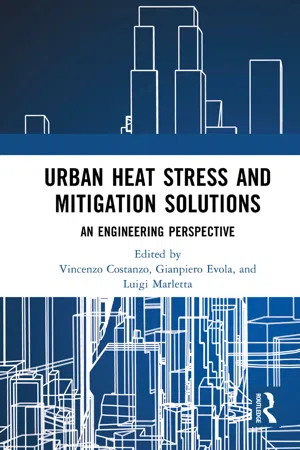
Urban Heat Stress and Mitigation Solutions
An Engineering Perspective
- 432 pages
- English
- ePUB (mobile friendly)
- Available on iOS & Android
Urban Heat Stress and Mitigation Solutions
An Engineering Perspective
About This Book
This book provides the reader with an understanding of the impact that different morphologies, construction materials and green coverage solutions have on the urban microclimate, thus affecting the comfort conditions of urban inhabitants and the energy needs of buildings in urban areas. The book covers the latest approaches to energy and outdoor comfort measurement and modelling on an urban scale, and describes possible measures and strategies to mitigate the effects of the mutual interaction between urban settlements and local microclimate.
Despite its relevance, only limited literature is currently devoted to appraising—from an engineering perspective—the intertwining relationships between urban geometry and fabrics, energy fluxes between buildings and their surroundings, outdoor microclimate conditions and building energy demands in urban areas. This book fills this gap by first discussing the physical processes that govern heat and mass transfer at an urban scale, while emphasizing the role played by different spatial arrangements, manmade materials and green infrastructures on the outdoor microclimate. The first chapters also address the implications of these factors on the outdoor comfort conditions experienced by pedestrians, and on the buildings' energy demand for space heating and cooling.
Then, based upon cutting-edge experimental activities and simulation work, this book demonstrates current and forthcoming adaptation and mitigation strategies to improve the urban microclimate and its impact on the built environment, such as cool materials, thermochromic and retroreflective finishing materials, and green infrastructures applied either at a building scale or at the urban scale. The effect of these solutions is demonstrated for different cities worldwide under a range of climate conditions. Finally, the book opens a wider perspective by introducing the basic elements that allow fuel poverty, raw materials consumption, and the principles of circular economy in the definition of a resilient urban settlement.
Frequently asked questions
Information
Part I
Physical processes and outdoor comfort in urban areas
1 Understanding heat and mass transfer at the urban scale
Introduction
The different scales of the urban heat island

- The microscale, where individual buildings, trees and other manmade constructions create an urban canopy that extends in height from the street level to the tallest building (so-called urban canopy layer, UCL) and horizontally for about hundreds of metres
- The local scale, made up of similar houses and urban contexts, extending from one to several kilometres horizontally and up to the roughness sublayer (RSL) in height. The RSL, which extends up to a few building heights, is the air volume where the turbulence effects, originated by manmade surfaces, mainly take place. Within a local climate zone, many different microscales coexist, which implies a great variability in the urban climate and the corresponding perceived heat stress
- The mesoscale, which includes various local scales horizontally and extends up to the urban boundary layer (UBL) vertically. The UBL extends from the top of the canopy layer up to the mixing layer and is characterised by the fact that its height depends on diurnal cycles. During daytime the UBL is typically well mixed because of the turbulence originated by rough and warm urban surfaces (with a typical extension of more than one kilometre), while during the night it shrinks to hundreds of metres
- Decreased long-wave radiation loss to the sky at night (atmospheric window), due to the presence of buildings and other obstructions
- Increased sensible heat storage due to the use of materials with high thermal admittance (e.g. concrete, asphalt, brick)
- Increased absorption of short-wave radiation due to the increased reflections from the surrounding surfaces, especially if they are covered with low-albedo materials
- Decreased evapotranspiration from pervious surfaces, water bodies, and vegetation, due to their reduced presence in urban areas
- Increased anthropogenic heat production
- Decreased convective heat transport due to reduction in wind speed
The urban energy balance
Table of contents
- Cover
- Half Title
- Title Page
- Copyright Page
- Contents
- Contributors
- Preface
- Part I: Physical processes and outdoor comfort in urban areas
- Part II: Urban energy modelling
- Part III: Adaptation and mitigation measures
- Part IV: Towards a resilient urbanscape
- Index